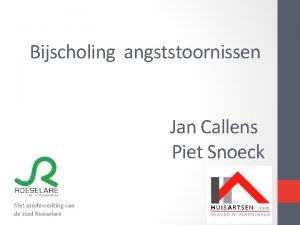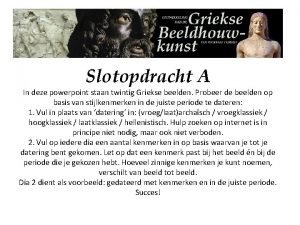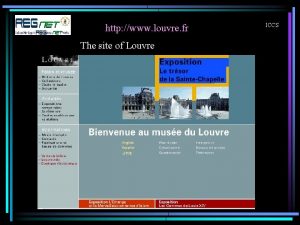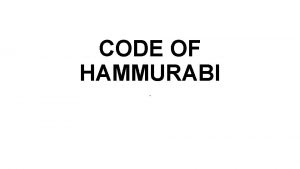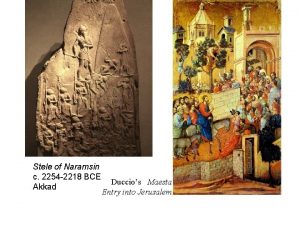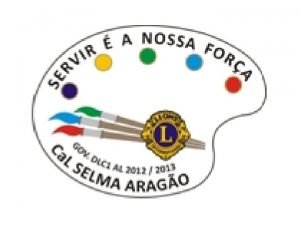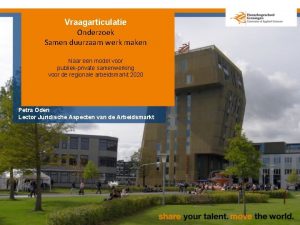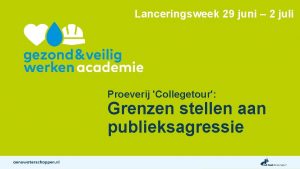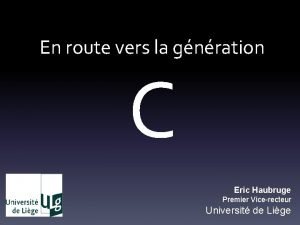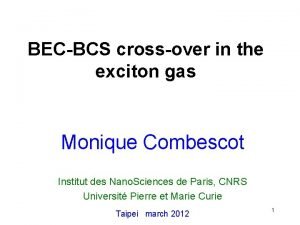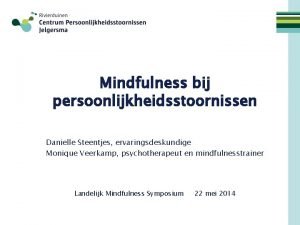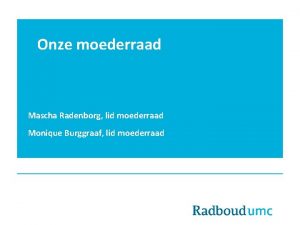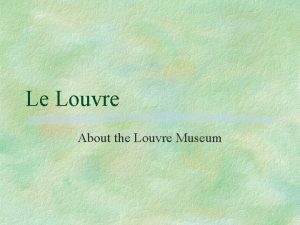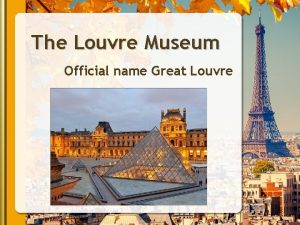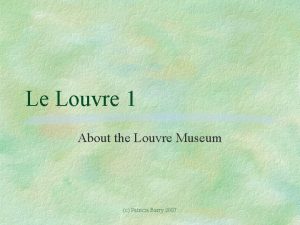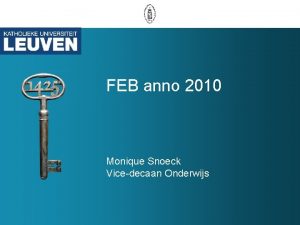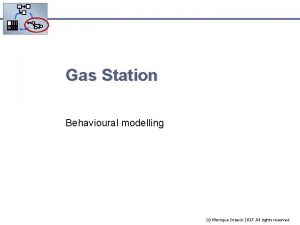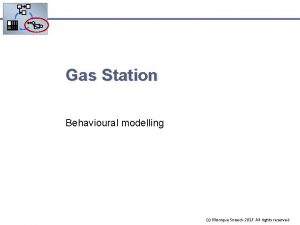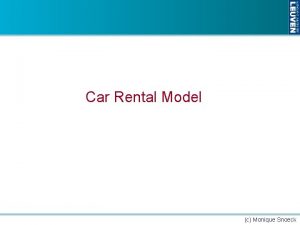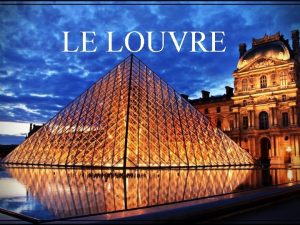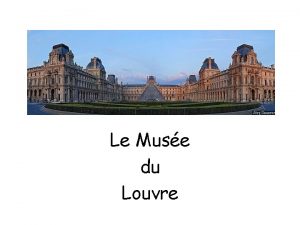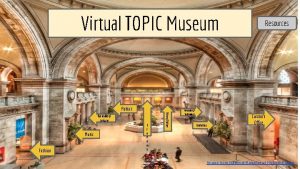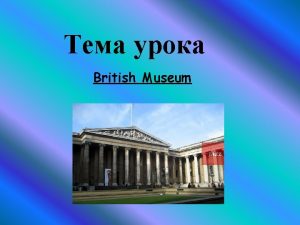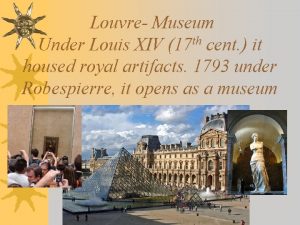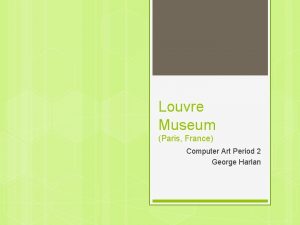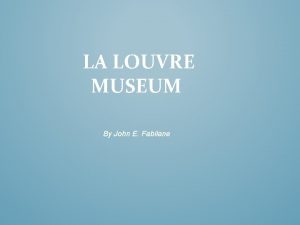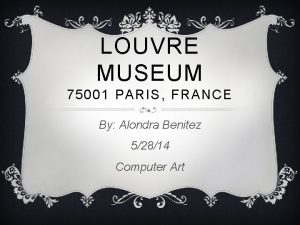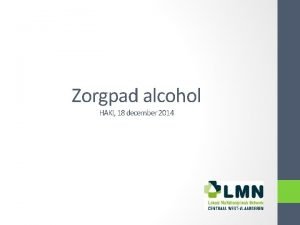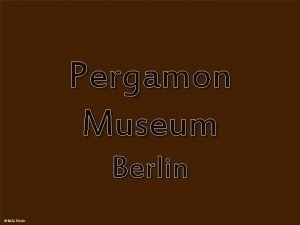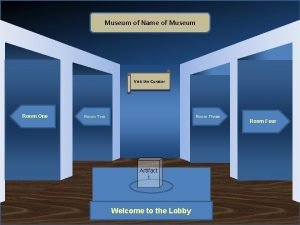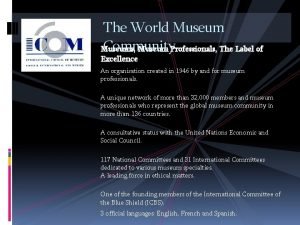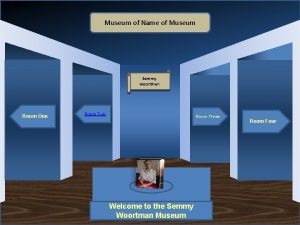Louvre Museum Development of modelsolution c Monique Snoeck


























- Slides: 26

Louvre Museum Development of model-solution (c) Monique Snoeck

2 Louvre 15: 23 The Louvre Museum in Paris is a huge museum with quite a large number of rooms, so that many exhibitions can be organised in parallel in the Museum. Also, the planning phase of an exhibition starts at least two years before the actual opening date of an exhibition, so that even for a single room, several exhibitions in different stages of advancement need to be followed up simultaneously. Therefore, a little management system is required to make sure all these exhibitions run smoothly. The museum has identified a set of locations inside the museum that can hold exhibitions. The locations can be considered as museums inside the museum, spanning e. g a part of or an entire floor or wing. So, for each location a series of exhibitions is developed. Each exhibition is assigned an employee of the museum as coordinator. First a series of desired exhibition items is defined. For example, for an exhibition on Vincent Van Gogh, it is defined that one item of his early period is desired, one pencil drawing with the corresponding painting, one sunflower painting, etc. For each desired item, a suitable piece is sourced from the collectors that possess candidate pieces. For some items, only one unique piece is available, but some exhibition items several potential pieces are available from different collectors. (There are for example several "Sunflower" paintings from Vincent Van Gogh). For each exhibition item, the system will keep track of what pieces are requested from which collector. To foster knowledge transfer, junior employees are assigned a senior employee as coach. This "coaching" relationship between employees is also tracked by the system.

3 Louvre The Louvre Museum in Paris is a huge museum with quite a large number of rooms, so that many exhibitions can be organised in parallel in the Museum. Also, the planning phase of an exhibition starts at least two years before the actual opening date of an exhibition, so that even for a single room, several exhibitions in different stages of advancement need to be followed up simultaneously. Therefore, a little management system is required to make sure all these exhibitions run smoothly. Louvre Museum Ø Universe of Discourse, not a Business Object Type Exhibition Ø will be the central Business Object Type 15: 23

4 Louvre UML Exhibition 0. . * 0. . 1 Location The museum has identified a set of locations inside the museum that can hold exhibitions. The locations can be considered as museums inside the museum. So, for each location a series of exhibitions is developed. § Note: the case description isn't really clear about the following questions § Does an exhibition need a location right from the start. § Can the location be changed? 15: 23 § If the answers are yes+no, then the association should be 1. . 1 on the side of location, and it expresses existence dependency. In case of yes/yes or no/yes, the association does not express existence dependency, and then association reification will be

5 Louvre EDG Exhibition 0. . * 1. . 1 Location The museum has identified a set of locations inside the museum that can hold exhibitions. The locations can be considered as museums inside the museum. So, for each location a series of exhibitions is developed. § Note: the case description isn't really clear about the following questions § Does an exhibition need a location right from the start. § Can the location be changed? § If the answers are yes+no, then the association should be 1. . 1 on the side of location, and it expresses existence dependency. 15: 23

6 Louvre EDG Exhibition 0. . * 0. . 1 Location The museum has identified a set of locations inside the museum that can hold exhibitions. The locations can be considered as museums inside the museum. So, for each location a series of exhibitions is developed. § Note: the case description isn't really clear about the following questions § Does an exhibition need a location right from the start. § Can the location be changed? § In case of yes/yes or no/yes, the association does not express existence dependency, and then association reification is required. 15: 23

7 Louvre UML Exhibition 0. . * 0. . 1 Location 1. . 1 0. . * Item For each exhibition, first a series of desired exhibition items is defined. For example, for an exhibition on Vincent Van Gogh, it is defined that one item of his early period is desired, one pencil drawing with the corresponding painting, one sunflower painting, etc. § An item is part of an exhibition once and for all. So this association expresses existence dependency. No reification is required. 15: 23

8 Louvre EDG 15: 23

9 Louvre UML Exhibition 0. . * 0. . 1 Location 1. . 1 Collector 0. . * Item For each desired item, a suitable piece is sourced from the collectors that possess candidate pieces. For some items, only one unique piece is available, but some exhibition items several potential pieces are available from different collectors. § For each items, several collectors are contacted. A collector may supply pieces for many exhibition-items. 15: 23

10 Louvre EDG According to this EDG, 1. you can only register pieces in connection to an exhibition item 15: 23 2. a Piece always refers to one and always the same item.

11 Louvre UML Exhibition 0. . * 0. . 1 Location 1. . 1 Collector 15: 23 1. . 1 0. . * Piece 0. . * Item For each desired item, a suitable piece is sourced from the collectors that possess candidate pieces. For some items, only one unique piece is available, but some exhibition items several potential pieces are available from different collectors. Alternative § The pieces that are possessed by a collector, may be recorded first, and then matched to exhibition items. This requires a model that is more extended. § You probably don't want to trace how collectors trade pieces in their

12 Louvre EDG Alternative According to this EDG, 15: 23 1. You can register pieces independently from setting up exhibitions 2. A piece can be used for several exhibition items: a same piece may be targeted by several exhibitions. Final assignment can then only be done if the time slots are non-overlapping (presumes a process of request that may be accepted or refused, to be captured in FSMs or BP layer).

13 Louvre UML 1. . Employee coordinator 1 0. . * Exhibition 0. . * 0. . 1 Location 1. . 1 Collector 1. . 1 0. . * Piece 0. . * Item Each exhibition is assigned an employee of the museum as coordinator. § Employee will not be existence dependent on the exhibition, nor is an exhibition existence dependent on an employee. So this association will need reification. 15: 23

14 Louvre EDG 15: 23

15 Louvre UML coached by 0. . * coach of 1. . 1 Employee coordinator 0. . * Exhibition 0. . * 0. . 1 Location 1. . 1 Collector 1. . 1 0. . * Piece 0. . * Item To foster knowledge transfer, junior employees are assigned a senior employee as coach. § Unary associations always need to be reified. 15: 23

16 Louvre EDG 15: 23

Louvre. Museum Advice based on student solutions (c) Monique Snoeck

Louvre - Feedback 1 2 1. Double check direction of association: which object exists first? 2. Objects in different states ==> in FSM

Louvre - Feedback 3. Different classes should not overlap in terms of instances 5 See chapter 8, Inheritance 4. Have meaningful names for business objects 5. Do not reify more than necessary: Is it required to be able to create exhibition items independently from an exhibition? Then find 3 4

Louvre - Feedback 5. Do not reify more than necessary ! Check lifecycles of objects! Only 1 association class is needed, not 3 Exhibition-Employee-ass = coordinatorship !

Louvre - Feedback 6. Double check cardinalities of (implicit) associations via all paths 6 6 How many exhitibion items/ pieces are connected to in_exhibition via the blue and the green path?

Louvre - Feedback § 7. Not more associations than needed

Louvre - Feedback 8. Do not include the Universe of Discourse as a business object type

Louvre - Feedback 9 9. Do not include information system 10 10. Do not include business process tasks

Louvre - Feedback 11. Do not confuse indirect associations with direct associations 11 An artist is related to an exhibition because his/her artwork is shown at the exhibition.

Louvre - Feedback 11 11. Do not confuse indirect associations with direct associations Rooms are related to an exhibition because they are related to the location. 11
 Piet snoeck
Piet snoeck Afrodite louvre
Afrodite louvre Meika syahbana rusli
Meika syahbana rusli Louvre ausstellungsstücke
Louvre ausstellungsstücke Www louvre fr
Www louvre fr Hammurabi code louvre
Hammurabi code louvre Le muse de louvre
Le muse de louvre What does lamassu symbolize
What does lamassu symbolize Louvre, mona lisa
Louvre, mona lisa Ecmo paris subway
Ecmo paris subway Monique mansoura
Monique mansoura Lisa purchases a professional racing bicycle
Lisa purchases a professional racing bicycle Fibroglandulair weefsel
Fibroglandulair weefsel Instituto melvin jones
Instituto melvin jones Monique beukeveld
Monique beukeveld Monique van limpt
Monique van limpt Danio kwark gezond
Danio kwark gezond Dr monique mackenzie
Dr monique mackenzie Monique marcourt
Monique marcourt Spin 1/3
Spin 1/3 Monique touzin orthophoniste
Monique touzin orthophoniste Monique thonnat
Monique thonnat Monique veerkamp
Monique veerkamp Monique barclay
Monique barclay 4-1 introduction to consumer credit
4-1 introduction to consumer credit Monique allen tolbert
Monique allen tolbert Monique burggraaf
Monique burggraaf
